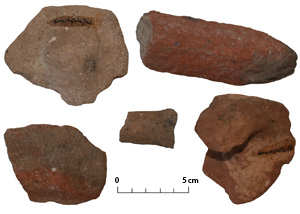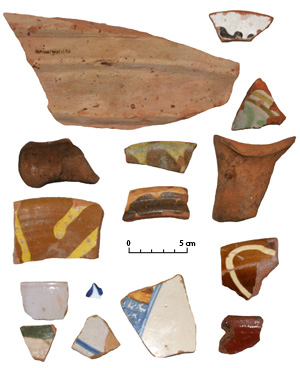Ελληνικά

under the aegis of the Canadian Institute in Greece and the Hellenic Ministry of Culture

Fragments of Middle Byzantine to early Venetian pottery from near Charchaliana. Photographs by J.J.P. ONeill.
ASP's medieval to recent pottery is being studied by Joanita Vroom (Sheffield), whose past work has done much to raise the academic profile and analytical importance of these late phases of ceramic material culture in the eastern Mediterranean.
Study of the entire assemblage from Antikythera will be completed in 2008, but the preliminary results are already very interesting: 5-7th century assemblages are relatively abundant on the island, but thereafter there is a dramatic decline in identifiable pottery dating to 8th-11th centuries. In contrast, 12-13th century pottery is found at several locations, including glazed fine wares, amphorae, and coarse wares.

Fragments of 17th to early 20th century pottery from near Kantiliana Photographs by J.J.P. ONeill.
While a few sherds suggest limited exploitation of the island's resources in the succeeding few centuries (especially in the 15th-16th centuries), the next peak period in terms of pottery evidence is the later 18th to early 20th century AD, which historical records suggest began with a recolonisation of the island by several families from the Chania area of western Crete. This final phase of pottery consumption is responsible for a wide distribution of material across the island, which offers great potential for exploring differences in pottery consumption between different Antikytheran households, spatial and functional correlations with standing buildings and agricultural installations, as well as evidence for off-island trade and/or local potting. Vroom also works on the survey pottery from neighbouring Kythera and, combining this with insights from the Antikytheran material as well as ongoing ethnoarchaeological study of modern Kytheran potting techniques and resources by Evangelia Kiriatzi, offers exciting possibilities for exploring differential patterns of regional pottery production and consumption in the south-west Aegean.